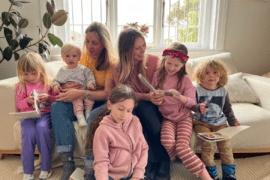By Donna Heather
“Oh, you get paid to play? That must be nice!”. I have heard this so many times over my career as a speech language therapist. Yes, it is nice to play, but so often people underestimate its power and importance. People think of play as fun and childish, but it is so much more. Play is how children learn.
Play is an opportunity for children to make sense of their world. There is so much to learn! Any play activity is a learning experience. Play builds attention and focus, as well as helping children to develop communication and cognitive skills.
It’s not just toys or objects that are important for play – “people games” are fantastic for building cognitive skills as well as communication.
People games are a playful interaction between you and your child, without the need for any other objects or materials. There is usually a repetitive element to the game, which gives children a structure – this can build anticipation, highlight the beginning and endpoint of the game, and also give children an opportunity to request repetition.
Peekaboo, chasing games, horsey rides, nursery rhymes with actions – these are all examples of people games. Many parents play these games often, without realising how important and beneficial they can be. Sure, they’re fun, but they are also so much more. If you think about playing a game of peekaboo with a baby, there are so many opportunities for learning and for building communication skills. In a game of peekaboo, babies learn how to initiate interactions and take turns, learn about concepts such as cause and effect and object permanence, and learn to attend to facial expressions and gesture.
And all of this important learning comes from a simple, easy game that requires absolutely nothing but the two people playing it.
Children love people games as much as babies. Horsey rides, nursery rhymes with actions and chasing games have the same benefits as peekaboo in that they are natural, fun ways to learn about interacting with others. During people games, children learn how to initiate and respond to a play partner, which is the exact same thing as a communication partner.
Communication is about interaction. We learn how to initiate conversations, attend to others and respond appropriately. We learn how to read other people’s body language, facial expressions and tone. We learn about boundaries, and we learn how to share. Play is communication in its purest, simplest form. It doesn’t start when babies learn to talk – it’s there from the very beginning.











